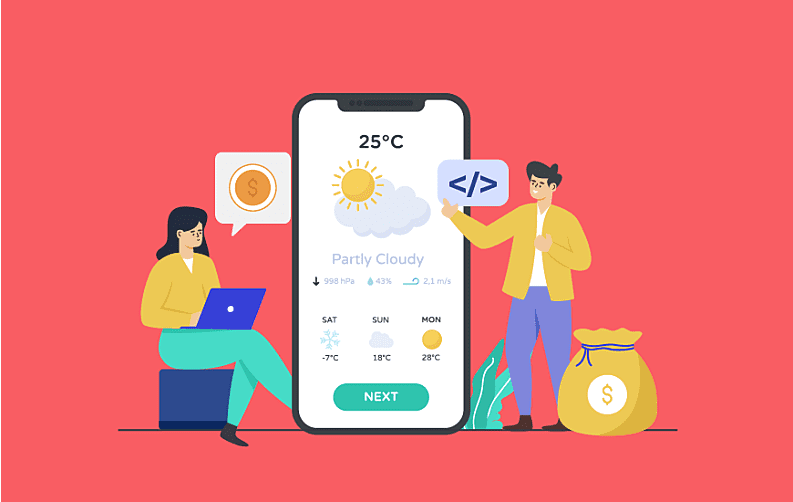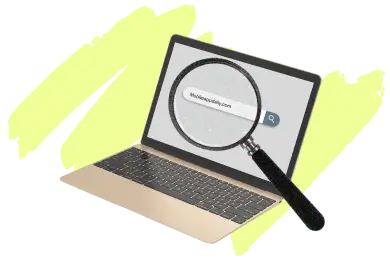
Staying informed about the weather has become an inseparable part of everyone’s daily lives. From planning your long weekends to full-fledged vacations or simply checking if you should bring an umbrella, a weather app is essential.
Most app development companies understand the significance of creating an app that caters to weather updates. Therefore, seeking plausible profits upon developing a weather app is not a farsighted dream.
To cater to this, we have written this article to help you create your weather forecast apps. We have tried to cover the entire spectrum, from different types of weather apps to weather app development costs. Therefore, let’s start with this guide on how to make your weather app.
Types of Weather Apps
Different types of weather apps are available, each designed to meet diverse user requirements and preferences. This is important to understand as it determines the cost of building a weather app. Understanding the diverse needs of users and tailoring your weather app to specific niches can also set your application apart in a competitive market.

1. Weather Forecast Apps
The weather forecast app is the most basic type that provides predictions about future weather conditions.
Normally, it offers a range of forecast metrics, from temperature and precipitation to wind speed and more.
Forecast apps are ideal for users planning daily activities, events, or trips and seeking a quick overview of upcoming weather conditions.
Weather App Development Cost Range: $5000 to $100,000+
2. Radar and Satellite Apps
For users who want a more in-depth understanding of weather patterns, radar and satellite apps are a must.
These applications provide real-time visualizations of precipitation, storm movements, and cloud cover, making them a perfect option for individuals living in regions prone to severe weather or preparing for upcoming storms.
Weather App Development Cost Range: $10,000 to $100,000+
3. Severe Weather Alert Apps
Severe weather alert apps are crucial in regions prone to extreme weather events, such as hurricanes, tornadoes, or floods.
Apart from regular weather metrics, these applications can send timely notifications to users and alerts, providing critical information about impending hazards and ensuring users can take appropriate precautions.
Weather App Development Cost Range: $5000 to $100,000
4. Climate Apps
While forecast apps focus on short-term predictions, climate apps delve into long-term weather trends and patterns. Users interested in understanding broader climate changes, historical weather data, and seasonal variations turn to these applications for comprehensive insights.
Weather App Development Cost Range: $5000 to $50,000
5. Travel and Outdoor Activity Apps
Designed for adventurers and outdoor enthusiasts, travel and outdoor activity apps provide weather information tailored to specific activities. Whether planning a hiking trip, a beach day, or a skiing excursion, users can receive forecasts customized to their chosen outdoor pursuits and pack accordingly.
Weather App Development Cost Range: $15,000 to $60,000+
6. Agricultural Weather Apps
Developed for farmers and agricultural professionals, agricultural weather apps offer specialized weather information relevant to crop planning, irrigation scheduling, and pest control.
By providing insights into soil conditions, temperature trends, and precipitation forecasts, these apps help farmers make informed decisions about a full cycle of the harvesting process.
Weather App Development Cost Range: $15,000 to $60,000+
7. Air Quality Apps
Beyond traditional weather parameters, air quality apps provide information about air quality, pollution levels, and environmental conditions.
This air type is particularly relevant for individuals with respiratory concerns or those living in areas prone to air pollution, helping them plan outdoor activities accordingly.
Weather App Development Cost Range: $10,000 to $50,000+
8. Social Weather Apps
These innovative apps leverage user-generated content and social networking features to improve weather reporting.
Users can share real-time weather updates, photos, and observations, promoting community engagement around weather events.
This application type appeals to users who value community-driven weather reports and want a more personalized, local perspective on current conditions.
Weather App Development Cost Range: $10,000 to $50,000+
Must-Have Weather App Features
Building a successful weather application requires more than standard mobile app development services. To create an app that users will find valuable and convenient, it's essential to incorporate features that can enrich their overall experience.
1. Accurate Forecasting
The cornerstone of any weather app is its ability to deliver accurate and up-to-date forecasts. Utilize reliable weather data sources to provide users with accurate information, including current conditions, hourly forecasts, and extended predictions.
2. Location-Based Services
Implement geolocation services to offer users personalized weather information based on their location. This confirms that the app provides relevant data, enhancing the user experience.
3. Push Notifications
It is an essential feature whether or not it pushes the cost to build the weather app. Push notifications inform users about important weather updates, alerts, and warnings. This feature is crucial for providing real-time information and ensuring user safety during rapidly changing weather conditions.
4. Interactive Maps
Incorporate interactive maps with real-time radar and satellite imagery. This feature is especially valuable for users who want to track their area's storms, precipitation, and other weather patterns.
5. Historical Weather Data
Include historical data, helping users review weather changes. This feature is valuable for users analyzing climate trends or planning events based on historical weather patterns.
6. Social Integration
Allow users to share weather updates on social media platforms. Social integration enhances community engagement and provides a place for users to share their weather experiences.
7. Offline Functionality
Ensure that users can proceed using basic weather information even when offline. This feature is necessary for those in areas with unreliable internet connectivity.
Benefits of Weather Apps
Understanding how to create a weather app or the cost of weather app development is secondary. Essentially, as a service provider, one needs to understand the reason behind the usage of a product. In this case, weather apps have several benefits because most smartphone users at least have one.
Understanding these benefits of weather apps will help you unwind the psyche of your target audience. It will help you ensure that you try to create a weather app that resonates with your audience. Therefore, let's check them out:
- Weather apps give you instant access to current weather conditions and forecasts, keeping users informed constantly.
- It helps users plan their daily activities, travel, and other events they might need to participate in.
- It gets updates related to serious weather incidents. For instance, storms, hurricanes, extreme temperatures, etc.
- It helps agriculture by sharing vital information such as rainfall, temperature, and other conditions.
- The user gets a weather forecast for a specific location, which can be customized to multiple locations.
- Weather apps assist in planning travel routes and schedules by providing forecasts and alerts.
- Users can get automatic updates on their home devices using IoT in weather technologies.
How to Create a Weather Application?
Developing a weather app involves a strategic and systematic approach to ensure functionality, accuracy, and user-friendliness. Here's a detailed instruction on how to build a weather app and bring your idea to life:
Step 1: Identify Your App's Goals and Target Audience
Start your project by determining who your app is for. Is it for daily commuters, outdoor enthusiasts, travelers, or a specific demographic? Understanding your audience helps shape the features and design of your app.
Another important thing while building a weather app is creating a list of the key features your app will have. Consider whether it'll be a simple weather app, a comprehensive forecast platform, or a solution with unique features like social sharing or climate trend analysis.
Step 2: Choose a Reliable Weather API
Select a reputable weather data provider/API in your process to create a weather app to source accurate and up-to-date information for your app. The options are diverse: OpenWeatherMap, WeatherStack, or the National Weather Service API.
Consider any usage limits, costs, and licensing agreements associated with your chosen weather API. This information is crucial for scalability and budgeting.
Step 3: Design the User Interface
Think of the app's structure and layout. Focus on an appealing yet intuitive design that prioritizes essential information, such as current conditions, forecasts, and additional features.
Also, ensure a consistent user experience by logically organizing information, implementing intuitive navigation, and optimizing for various screen sizes and devices.
Step 4: Develop the App
Decide whether your app will be native (iOS, Android) or cross-platform. Each option has its pros and cons and directly impacts factors like development time, cost of weather app development, and performance.
Step 5: Test Thoroughly
Don't overlook testing every aspect of your app's functionality, including data accuracy, location services, and feature interactions, to detect and eliminate any bugs or issues.
Also, take your time to conduct user testing and collect feedback on the app's usability. Consider user suggestions for improvements and implement necessary changes.
Step 6: Deployment
Prepare your app for submission to app stores. Follow the guidelines of platforms like the Apple App Store and Google Play to guarantee a flawless acceptance process.
Regularly monitor user feedback, app performance, and weather data accuracy. Keep your app updated with fresh features, bug fixes, and optimizations.
Step 7: Marketing and Promotion
Develop a marketing strategy to promote your weather app. Use social media, app store optimization (ASO), and other channels to improve brand awareness.
Finally, cultivate a community around your app by engaging with users through social media, responding to reviews, and addressing user concerns.
Best Weather App Examples
When building a weather app, taking inspiration from successful applications can provide valuable insights. Let's delve into a few notable weather apps that have gained popularity and set industry standards.
1. AccuWeather

AccuWeather is known for its global coverage and accuracy in providing forecasts. It offers many features, including minute-by-minute precipitation forecasts, lifestyle forecasts, and health indices.
Its flagship RealFeel temperature feature, which considers factors like humidity and wind, improves the app's accuracy in predicting how the weather truly feels.
2. Weather Underground
Weather Underground takes a unique strategy by incorporating crowdsourced data from its vast network of personal weather stations. This community-driven model improves the accuracy of local forecasts.

3. Yahoo Weather
Yahoo Weather combines accurate forecasting with a visually stunning design. The app showcases user-submitted photos of current weather conditions, providing a customized and exciting experience.

Best Practices in Weather App Development
Building a weather app is one thing, but doing it accurately meets the deadlines the client instated is something else. For that, the development teams should align with the entire process and the quality of it. The best way to ensure this is by using the best practices in weather app development.
To give a better idea, here are some of the most common best practices while developing a weather app:
- User-friendly Interface: Try to create a clean, intuitive, and easy-to-navigate design with icons and symbols for the application.
- Accurate Weather Data: Use reliable data providers or APIs that ensure your app is updated with accurate and updated information at every instance.
- Location-Based Services: Utilize GPS and geolocation services to provide users with accurate local weather information. One should also provide the capability to input the user location data manually.
- Real-Time Updates: Provide real-time updates related to weather conditions, forecasts, and alerts by implementing push notification features.
- Multilingual Support: If you wish to go global, creating a weather app with multilingual support is essential.
- Offline Functionality: This feature allows users to access cached or preloaded weather information during network issues.
- Historical Data: The weather app creation should incorporate historical weather data and trends for users.
- Cross-Platform Compatibility: Make the application such that it is compatible with all the common platforms, i.e., iOS, Android, Web, etc.
- Testing: Thoroughly test the app across different devices, screen sizes, and operating systems.
Weather app development cost
The cost of developing a weather app can vary based on several factors. Factors include features, complexity, platforms, design, and geographic location of the team. Therefore, we have segregated the associated costs to have a potential breakdown of the cost to build a weather app. Therefore, let’s check them out:
1. Basic Weather App
A simple weather app with basic features such as current conditions, daily forecasts, and location-based services can cost $10,000 - $30,000.
2. Adding Advanced Features
Incorporating advanced features such as hourly forecasts, interactive maps, and multiple location supports adds more to the cost to build a weather app. The cost of achieving this would range between $30,000-$50,000.
3. Real-Time Updates and Notifications
To implement real-time weather updates, push notifications, and provide severe weather alerts, the cost can range from $50,000 to $80,000.
4. Customization and User Preferences
Customization features include theme selection, temperature units, and language support. The cost to add these can range between $15,000 to $30,000, depending upon the level of customization and quality.
5. Offline Functionality
Developing offline features for your weather is an essential part of it. This, however, required cached weather data without an internet connection. Adding this feature can range between $10,000 to $20,000.
6. Interactive Maps and Data Layers
One must integrate interactive maps, radar, satellite imagery, and historical weather data to create this. The cost to integrate these might range between $30,000 to $60,000.
7. Cross-Platform Development
Developing the app for multiple platforms such as iOS, Android, and web. This includes additional costs ranging between $50,000 to $100,000.
8. Testing and Quality Assurance
You need rigorous testing on various devices, screen sizes, and operating systems to shell out a great weather application. This is to ensure that the app created is bug-free. Doing this for the application can cost between $15,000 to $30,000.
9. Security Features
It is another essential feature of a weather app. It is important to ensure that your application complies with current regulations and there is no threat to user data. Adding this level of security could range between $20,000 and $40,000.
10. Maintenance and Updates
After your application's launch, maintenance and updates would incur a consistent expense. Post-launch, providing support, bug fixes, and updates is essential to keep the app functional and updated. This could annually range between 15-20% of the total development cost.
If we sum up the cost of this advanced weather app, it would easily range between $200,000 to $400,000, or more. This price could also change based on requirements and development team rates. To get a specific price, you must talk with your development partner to get a much more accurate estimate.
Conclusion
Developing a weather application necessitates thorough planning, stunning design, quality development, and a grasp of the cost to build a weather app. By comprehending various types of weather apps, integrating essential features, and adhering to a systematic development process, you can build an application that fulfills user expectations and distinguishes itself in the market of weather applications.
Frequently Asked Questions
-
Can you use AI in weather app development?
-
How much does it cost to develop a weather app?
-
How much time does it take to build a weather app?
-
What is weather app web development?
-
Briefly describe the weather app development process.
-
Describe the weather app development life cycle.




















